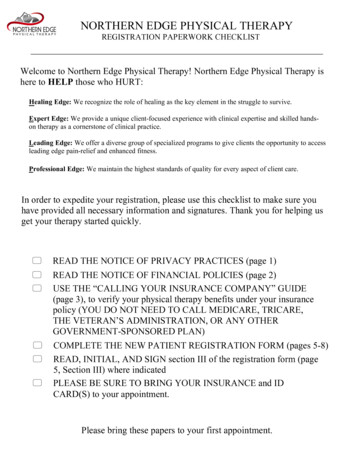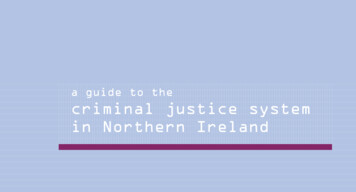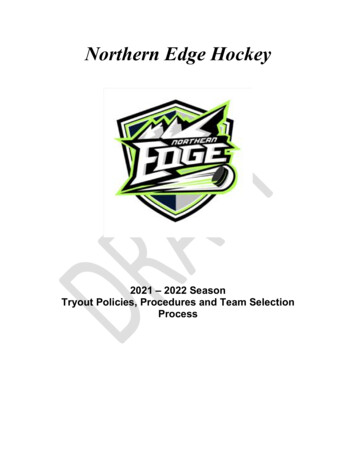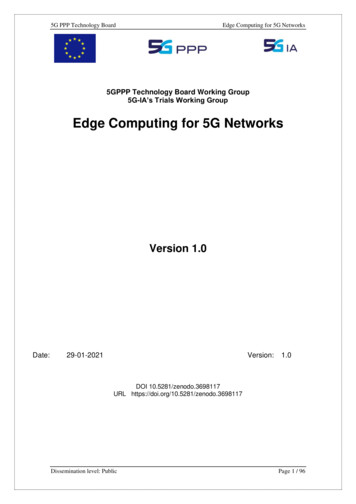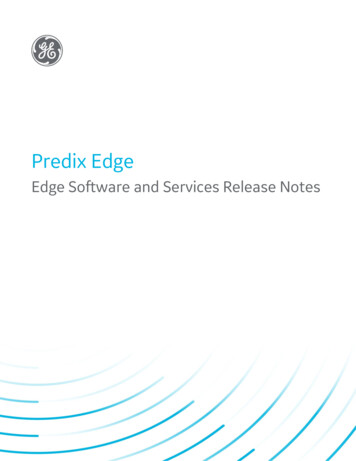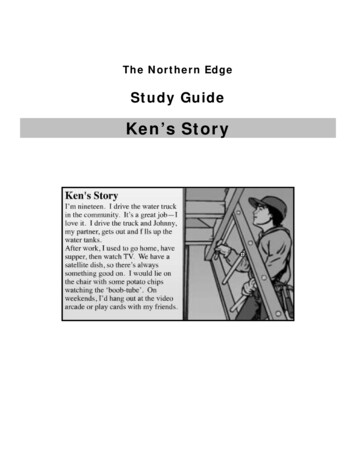
Transcription
The Northern EdgeStudy GuideKen’s Story
TThhee NNoorrtthheerrnnEEddggeeKen’s StoryKen’s StoryIntroductionThis story is from Issue #1 of The Northern Edge. Ken’s story isabout active living. Learning activities on-line include spellingquizzes and a content quiz.This story offers an opportunity to encourage learners to makeregular physical exercise and healthy eating part of their daily lives.This section first presents a list of 12 learning activities and thewritten text for Ken’s Story. The pages following the written textgive instructor notes and handouts for each activity, in the order onthe list.Some activities are short and others take up to a week to complete.Some involve physical activity as well as literacy skills.This symbol marks the written text for Ken’s Story.This symbol marks instructor notes.This symbol marks handouts to copy for learners.The Northern Edge Study Guide1-1
TThhee NNoorrtthheerrnnEEddggeeKen’s StoryKen’s StoryList of Learning ActivitiesInstructor NotesHandoutsPage #s1) Vocabulary2 handouts13 to 172) Language skills1 handout13, 183) Questions2 handouts19 to 224) Writing2 handouts19, 23, 245) Active living role modelsNo handout256) Walk the community **No handout267) Five Senses **2 handouts27 to 298) Where’s the action? **2 handouts30 to 359) The newsletter **1 handout36, 3710) Active living **5 handouts38 to 4811) Let’s make a meal2 handouts49 to 5412) Time to get activeNo handouts55** These activities include some physical activity.The Northern Edge Study Guide1-2
TThhee NNoorrtthheerrnnEEddggeeKen’s StoryText - Ken’s StoryIssue #1 The Northern EdgeI’m nineteen. I drive the water truck in the community. It’s a greatjob - I love it. I drive the truck and Johnny, my partner, gets out andfills up the water tanks.After work, I used to go home, have supper, then watch TV. Wehave a satellite dish, so there’s always something good on. I wouldlie on the chair with some potato chips watching the ‘boob-tube’.On weekends I’d hang out at the video arcade or play cards with myfriends.Then I met Sara. I really like her. She’s got so much energy. Shedidn’t say I was a couch potato, but I knew she thought that.One day I asked her, “ How come you have so much energy?”She told me, “It’s because I look after myself. I try to eat healthyfood and I like to be active. If you’re active, you’ll be healthier andhave lots of energy.”I told her I was no ‘jock’, that I didn’t like sports.She said, “That doesn’t matter. Being active is not just playingsports.”She talked about something called ‘active living’— about peoplebeing active every day.Sara said, “You can do almost anything — walk, do chores likechopping wood. The important thing is to pick some things you likeThe Northern Edge Study Guide1-3
TThhee NNoorrtthheerrnnEEddggeeKen’s Storydoing and do them every day. You can do different things for 10minutes at a time then add them up, until you have between 30 to 60minutes.I decided I’d give it a go. Boy, it was hard getting started! At first, Ijust got out of the water truck and gave Johnny a hand with thehose. That wasn’t too bad.Then I decided I’d walk to work instead of driving. I only live tenminutes away anyway. Then Johnny asked me to help him build askidoo shack. We hauled wood and climbed up and down theladder.Now I try to do things every day. I feel pretty good about myselfand I can see Sara feels pretty good about me too!The Northern Edge Study Guide1-4
TThhee NNoorrtthheerrnnEEddggeeKen’s StoryVocabularyLearning Activity 1Two handouts1-1: What do these words mean?Learners look for the best meaning for words from the story.1-2: What do these idioms mean?Learners explore the meaning of some English idioms.Language skillsLearning Activity 2One handoutThis activity uses words from Ken’s story. Learners fill in the wordblanks on the handout in the story ‘Installing the Satellite Dish’.The Northern Edge Study Guide1-5
TThhee NNoorrtthheerrnnEEddggeeKen’s StoryVocabularyLearning Activity 11-1: What do these words mean?Use a dictionary and write down the best meaning for these wordsfrom Ken’s story. Look up any other words from the story youdon’t understand.1) Arcade2) Satellite3) Community4) DecidedThe Northern Edge Study Guide1-6
TThhee NNoorrtthheerrnnEEddggeeKen’s Story5) Nineteen6) Energy7) LieThe Northern Edge Study Guide1-7
TThhee NNoorrtthheerrnnEEddggeeKen’s StoryVocabularyLearning Activity 11-2: What do these idioms mean?You learn what some English words mean just from the way peopleuse them. You won’t find them in the dictionary. These words arecalled ‘idioms’. What do these idioms mean? Does Ken’s story haveother idioms?1) Boob tube2) Couch potato3) JockThe Northern Edge Study Guide1-8
TThhee NNoorrtthheerrnnEEddggeeKen’s Story4) Give it a go5) Hang out6) Feel pretty goodOther idioms?The Northern Edge Study Guide1-9
TThhee NNoorrtthheerrnnEEddggeeKen’s StoryLanguage skillsLearning Activity 2Use these words to fill in the blanks in the story yliecouch potatoInstalling the Satellite DishThe first television programs in the NWT were short. They lastedonly four hours every evening. When I wasyears old, our received a TV signal by.My dad asked me to install the dish on the top of our house. I didnot have the to haul the ladder out ofthe shed and climb on the roof to do the job. I liked being a. I would rather play gameswith my friends at the .When my father came home, he told me what a good job I did. Icould not tell a . I to betruthful and tell him I paid my brother to do it for me.The Northern Edge Study Guide1 - 10
TThhee NNoorrtthheerrnnEEddggeeKen’s StoryQuestionsLearning Activity 3Two handouts3-1: Story questionsLearners answer questions about Ken’s story. The handout askslearners to use a full sentence with correct punctuation.3-2: Journal writingLearners use questions in the handout to guide their journalwriting.WritingLearning Activity 4Two handouts4-1: Working with wordsLearners use a list of words from Ken’s story to write aparagraph.4-2: Sentence combiningLearners combine short sentences into longer sentences.The Northern Edge Study Guide1 - 11
TThhee NNoorrtthheerrnnEEddggeeKen’s StoryQuestionsLearning Activity 33-1: What did we learn about Ken?Answer the following questions in sentences. Begin with a capitalletter and end with the correct punctuation.1) What is Ken’s job in the community?2) How do you know that Ken is not an active person?3) Why didn’t Sara call Ken a ‘couch potato’?The Northern Edge Study Guide1 - 12
TThhee NNoorrtthheerrnnEEddggeeKen’s Story4) Why do you think Sara told Ken about ‘active living’?5) How does Ken feel once he starts to get some exercise?6) How does Ken know that Sara feels pretty good about him?The Northern Edge Study Guide1 - 13
TThhee NNoorrtthheerrnnEEddggeeKen’s StoryQuestionsLearning Activity 33-2: Journal writingUse these questions to guide your journal writing.What is your reaction to this story?What can happen to you if you are a couch potato?How do you make time in your busy life to keep active?What activities keep you active?How do you feel when you are finished your activity?Do you encourage your family and friends to be active?The Northern Edge Study Guide1 - 14
TThhee NNoorrtthheerrnnEEddggeeKen’s StoryWritingLearning Activity 44-1: Working with wordsChoose five or more words from the list below. Use these words towrite a paragraph in a way that connects these five words. Put atitle with your ateThe Northern Edge Study Guide1 - 15
TThhee NNoorrtthheerrnnEEddggeeKen’s StoryWritingLearning Activity 44-3: Sentence CombiningWriters sometimes combine short sentences into longer sentences.Example 1: Judy delivers newspapers. She delivers them afterschool. She does this to earn money.Judy delivers newspapers after school to earn money.Example 2: Half of the money is for videos. Half of the money isfor savings.Half of the money is for videos and half is for savings.Combine these short sentences into one longer sentence.Sarah likes to be active. She walks to work every day. Sarah playshockey twice a week.Ken needs more exercise. He needs 60 minutes of exercise everyday. He needs exercise to keep healthy.The Northern Edge Study Guide1 - 16
TThhee NNoorrtthheerrnnEEddggeeKen’s StoryActive living role modelsLearning Activity 5No handout5-1: Write a paragraphAsk learners to choose a famous person, a friend, or someone elsethey admire because of their active lifestyle.Ask learners to write a paragraph to describe:What does this person do that impresses you?What does this person do to keep active?How does this person influence you and others to keepactive?5-2: Write a letterAsk learners to write a letter to someone who has been an activeliving role model for them. For example: a sports hero, a dramacoach, or a physical education teacher.Ask learners to describe the impact the role model had on thelearner’s life. How did the role model help them to be moreactive?The Northern Edge Study Guide1 - 17
TThhee NNoorrtthheerrnnEEddggeeKen’s StoryWalk the communityLearning Activity 6No handoutGive the learners a map of their community. Or make a map of thecommunity together.Challenge the learners to walk every street. Ask them to mark offthe streets on the map as they finish each one.Choose a walking buddyWalk 15 minutes during class timeMake it a personal challenge - walk every eveningAsk people to keep track of how much time they walk everydayHave a contest to see who can finish walking all the streetsfirstHave a contest to see who spends the most time walking overone week or one monthThe Northern Edge Study Guide1 - 18
TThhee NNoorrtthheerrnnEEddggeeKen’s StoryThe five sensesLearning Activity 7Two handoutsUse this activity to introduce paragraph writing to 110 learners andas a review for 120 learners. They also get some physical exercise.Our five senses include our eyes, ears, nose, taste buds, and skin.We use our five senses to see, hear, smell, taste, and touch or feel.7-1: Senses at homeAsk learners to do this handout. It asks them to brainstorm andlist things they see, hear, smell, taste, and touch at home.Then go for a walk in the community.7-1: Senses in the communityAfter the walk, brainstorm all the things people saw, heard,smelled, tasted, and touched in the community. Ask the learnersto fill out the second handout after the brainstorm.Prepare learners to write a paragraph. Brainstorm for a main ideaand a closing sentence.Model an outline of a paragraph on the board to show how the mainidea, supporting details, and the closing sentence fit together.Learners who have difficulty with spelling and writing do well withthis strategy.Ask learners to write a paragraph with the brainstormed main ideaand closing sentence.The Northern Edge Study Guide1 - 19
TThhee NNoorrtthheerrnnEEddggeeKen’s StoryThe five sensesLearning Activity 77-1: Senses at homePeople have five senses. We use our eyes, ears, nose, taste buds, andskin to help us understand the world. Brainstorm at least threethings you can see, hear, smell, taste, and feel or touch at home.In my home I SeeHearSmellTasteTouch or feelThe Northern Edge Study Guide1 - 20
TThhee NNoorrtthheerrnnEEddggeeKen’s StoryThe five sensesLearning Activity 77-2: Senses in the communityUse this handout after you take a walk in your community.In my community I SeeHearSmellTasteTouch or feelWrite a paragraph to describe your experience. Use the words andphrases above. Write about 6 to 10 sentences. Remember, the firstsentence introduces the paragraph. The last sentence closes theparagraph. What is the title of your paragraph?The Northern Edge Study Guide1 - 21
TThhee NNoorrtthheerrnnEEddggeeKen’s StoryWhere’s the action?Learning Activity 8Two handoutsLearners do research and writing, and produce a brochure aboutsummer and winter activities available in their community. Thisactivity takes some time and may happen over several days.8-1: Community activitiesLearners work in pairs to make a list of all the summer andwinter activities available in their community. Encourage themto talk to lots of different people and agencies. For example: thehealth centre, recreation centre, visitor information, arena, bandoffice, daycare, seniors, youth centre, women’s group. Ask eachpair to share their list and make one big list.8-2: More about community activitiesDivide up the big list among the pairs. Ask each pair to use thesecond handout to write down some details about each activityassigned to them.Use the information to write a brochure for the community. Or lookat other ways learners can share the information with the community.Have a class discussion:What other activities would learners like to have in theircommunity?What’s the best way to initiate new activities in thecommunity?The Northern Edge Study Guide1 - 22
TThhee NNoorrtthheerrnnEEddggeeKen’s StoryWhere’s the action?Learning Activity 88-1: Community activitiesWith a partner, list all the summer and winter activities people do inyour community. Talk to lots of different people and agencies.Summer activitiesWinter activitiesThe Northern Edge Study Guide1 - 23
TThhee NNoorrtthheerrnnEEddggeeKen’s StoryWhere’s the action?Learning Activity 1-88-2: More about community activitiesFind out more details about each summer and winter activity. Foreach activity ask: What? When? Where? How? Who? Why?Make a brochure to share this information with your community.Name of the activityWhen does it happen?Winter, summer, daylight, any timeScheduled time or notWhere do people participate?Inside or outsideA specific building or outside areaHow do people participate?Need other people or do it on your ownDo people need special equipmentWho can participate?Can any or all ages participateCan men and women participateWhy do people participate?Learn skillsFun, socializeBuild strength or enduranceThe Northern Edge Study Guide1 - 24
TThhee NNoorrtthheerrnnEEddggeeKen’s StoryHow to organize a brochureA brochure is usually one piece of paper folded to make threepanels. This diagram shows the two sides of the page when it’sopen. Use sample brochures and this diagram to help decide whatpictures or words belong in each panel. Use a computer and apublisher program, if you have one.Inside leftInside middleInside rightBack leftBack coverFront coverThe Northern Edge Study Guide1 - 25
TThhee NNoorrtthheerrnnEEddggeeKen’s StoryFront coverUsually has the title and a picture or drawing. Not much text. Getpeoples’ attention. Catch their eye.Back coverUsually includes name, address, phone, email, website or othercontact information.Inside right, middle, leftText, pictures, drawings, etc. What are the most important thingspeople need to know? Try things different ways to see what worksbest. Use as little text as possible.Back leftPeople see this panel when they open the first panel of the brochure– before they open it up the whole way.To print the brochureCopy each page on one side of the same piece of paper. Make sureeach side is the same way up. Use coloured paper?The Northern Edge Study Guide1 - 26
TThhee NNoorrtthheerrnnEEddggeeKen’s StoryMake a brochure by hand:Fold two pieces of paper into three equal sections. Or measure threeequal sections on the page and a draw a line to separate them.Make a brochure on the computer with a word processingprogram:Under file go to page setup:Set the margins very small – about .25 inches. Change thislater if it’s too large or too small.Set the paper size as landscape.Under format go to columns:Set the number of columns as three.Set the spacing as .75 inches. Change this later if it’s too largeor too small.Start from the top left corner. To move down the column, to getfrom one column to the next, or onto another page – type in text orpush the ‘Enter’ key over and over.The Northern Edge Study Guide1 - 27
TThhee NNoorrtthheerrnnEEddggeeKen’s StoryThe newsletterLearning Activity 9One handoutLearners produce a newsletter about some aspect of active living inthe community. Ask learners to brainstorm a topic. Look for ideasin ‘Where’s the Action’ Learning Activity 1-8, if you need to.Each learner or pair of learners produces something for thenewsletter. For example: a story, picture, interview, drawing, ormap. This activity can easily accommodate different literacy levels.For example, lower literacy learners can do word searches, drawingswith descriptions, or maps where community activities and sportstake place. Learners may go into the community for information.Bring all the items together and brainstorm how to organize thenewsletter. Where will the pictures and artwork go? Where will thestories go? Do some stories need to be shorter?The newsletter helps learners understand how to be brief. Withlimited space, they learn to include the most important informationand leave out the rest. The General Resource ‘Writing ProcessGuide’ may be helpful.Once learners decide how to put the newsletter together, eachperson or pair needs to make sure their story or drawing fits thespace. Usually learners need to make changes for things to fittogether well.After learners make all the changes, put the newsletter together,print it, and give it out around the community.The Northern Edge Study Guide1 - 28
TThhee NNoorrtthheerrnnEEddggeeKen’s StoryThe newsletterLearning Activity 9Use the ideas on this handout to produce something for thenewsletter. Work on your own or with a partner.Here are some ideas of things you can do:Interview someone and write about itWrite a story or describe something in writingDraw pictures or mapsTake photosWrite a poem or find a poem. Look for interesting poemssuch as diamante, haiku, and shape poems.Research statisticsDraw a graphDo a word searchBe creative. Use your own ideas.After everyone has something for the newsletter, get together andlook at what you have. Brainstorm how to put the newslettertogether. Where will you put the pictures or artwork? Do you needto make any stories shorter? What will you call the newsletter?After you decide how to put the newsletter together, go back to yourown story or drawing and make sure it fits. Change it if you needto. Ask other students to check your work.Print the newsletter and give it out to people in the community.The Northern Edge Study Guide1 - 29
TThhee NNoorrtthheerrnnEEddggeeKen’s StoryActive livingLearning Activity 10Five handoutsLearners look at their own level of physical activity for one week. Ittakes over a week to complete. Some handouts may be useful forindividual lessons.10-1: How active are you?Learners think about physical activity in their own life.10-2: Why should I be active?Learners understand why active living is important. Before yougive them the handout brainstorm two things: the benefits ofactive living and the risks of lack of physical activity and healthyeating.10-3: How much physical activity do you do in a week?Learners write down what physical activity they do each day fora week and the total time. They calculate the average time perday they were physically active.10-4: How active do you need to be?Learners assess how much effort they put into their presentphysical activity.10-5: What’s my goal?Learners decide how they can increase their physical activity.They can use the information from Learning Activity 8 ‘Where’sthe action’ for ideas.The Northern Edge Study Guide1 - 30
TThhee NNoorrtthheerrnnEEddggeeKen’s StoryActive livingLearning Activity 1010-1: How active are you?Our parents and grandparents hunted, fished, lived on the land, andworked hard to raise their children. Our ancestors were physicallyactive in their daily lives.Today physical activity is different. We often take the car, truck, orskidoo to school or work, instead of walking or riding a bike. We sitat a desk or computer all day, often without any break during theday for physical activity. We watch TV or play video games in ourspare time instead of playing sports, going hiking, or doing someother physical activity. But we can choose differently. Physicalactivity can be part of our daily lives.Think about physical activity in your own life.1)How active are you on a scale of one to ten?1 5 10notsomewhatveryactiveactiveactive2)Do you like being active? Why or why not?The Northern Edge Study Guide1 - 31
TThhee NNoorrtthheerrnnEEddggee3)Ken’s StoryIn what places are you active? For example: at work, school,home, the ball diamond, the community centre, the arena, orother places. At what times are you active? For example:morning, afternoon, evening, at night.List the places and the times that you get physical activity.Places4)TimesAre you active on your own or with other people? Who are youactive with?The Northern Edge Study Guide1 - 32
TThhee NNoorrtthheerrnnEEddggeeKen’s StoryActive livingLearning Activity 1010-2: Why should I be active?After the brainstorm review this list. Are there things to add fromthe brainstorm?Benefits: physical activityRisks: lack of physical activityHealthy body, mind, spirit,emotionOverweight or obesePrevent diseaseHigh blood pressureBuild strong family andcommunityFeel tired, low energyEnergy and fitnessStrong bones and musclesHave fun, enjoy peoplePlay with kidsGood self-esteemLive longerGood posture and balanceLive more independently aswe ageLook and feel goodHeart diseasePoor night ressBackacheColon cancerSpend more money treatingdiseasesStrong heartSleep wellThe Northern Edge Study Guide1 - 33
TThhee NNoorrtthheerrnnEEddggeeKen’s StoryActive livingLearning Activity 1010-3: How much physical activity do you do in a week?Use the table on the next page to write down the physical activitiesyou do each day. Examples include sports, walking, riding a bike,chopping wood, hunting, fishing, gardening, or housework.Keep track of the time you spend on each activity. Write down thetotal time for each day and for the week.Did you know?Over half of the adults in the NWT aren’t active enough to get themost health benefits.The Canadian Fitness and Lifestyle Research Institute, PhysicalActivity Monitor, June 2000 tells us:13% of NWT adults are inactive. More women than men areinactive.18% of NWT adults are only somewhat active.25% of NWT adults are moderately active, but not activeenough to get the most health benefits.45% of NWT adults are active enough to get the most healthbenefits.The Northern Edge Study Guide1 - 34
TThhee NNoorrtthheerrnnEEddggeeKen’s StoryMy physical activity for one weekTime per daySat.Fri.Thur.Wed.Tues.Mon.Sun.Date:Total time for the weekThe Northern Edge Study Guide1 - 35
TThhee NNoorrtthheerrnnEEddggeeKen’s StoryCalculate the average amount of physical activity you get.At the end of the week, find out the average number of minutes ofphysical activity you did.To find the average:Total minutes for the week minutes per day7 daysFill in your own numbers: minutes per day7 daysThe Physical Activity Monitor also tells us that:60% of children 5 to 17 years old are not active enough togrow and develop in the best way.69% of Canadians make some active choices in their workroutine, such as walking or biking to work.66% of Canadian adults know that activities such as a briskwalk, a bike ride, or jogging help our endurance.The Northern Edge Study Guide1 - 36
TThhee NNoorrtthheerrnnEEddggeeKen’s StoryActive livingLearning Activity 1010-4: How active do you need to be?You should aim to be active for 60 minutes each day.You don’t need to be active for 60 minutes all at once. Youcan do it in blocks of time. For example, walk to work orschool 15 minutes, play sports for 30 minutes, and walk homefrom work or school 15 minutes. Add the blocks up until youhave 60 minutes.How much time you need also depends on how much effortyou put into your physical activity. For example, 20 minutesof running takes way more effort than 20 minutes walking.This chart shows activities with different amounts of effort.The Northern Edge Study Guide1 - 37
TThhee NNoorrtthheerrnnEEddggeeKen’s StoryHow much effort do I put into physical activity?Write down the physical activities from your list in Handout 10-2.Use the chart on the last page and decide how much effort you putinto different physical activities you do.The Northern Edge Study GuideMaximumVigorousModerateLightActivitiesVery lightthe level of effort for each activity1 - 38
TThhee NNoorrtthheerrnnEEddggeeKen’s StoryActive livingLearning Activity 1010-5: What’s my goal?In the story, Ken found it hard to get started. He decided to startwith walking to work. Then over time he added other activities.Develop a goal to do more physical activity every day. Here aresome ideas to get started:Start slowly and build up to 60 minutes a day.Do activities in blocks of time during the whole day.Do your regular physical activities more often.Choose some activities that need more effort.Walk or ride a bike to get places, instead of driving.Spend less time watching TV or playing video games.At work or school, get up from your desk every hour or twoand stretch for five minutes.Learn what physical activities your community offers.Do physical activity with a friend or a family member.Do physical activity you like to do.Try new things.Look at the list of summer and winter activities in your communityfrom Learning Activity 8 ‘Where’s the Action’. What activities inthat list do you already do? What other activities on that list wouldyou like to do, to help you become more active? Write down yourideas. Talk about the ideas. Visit these websites for more .fitnessfever.comThe Northern Edge Study Guide1 - 39
TThhee NNoorrtthheerrnnEEddggeeKen’s StoryMy GoalI plan to do these three things to start being more active1)2)3)How do you plan to measure your progress?For example, keep track of how many minutes of physical activityyou do every day or every week, and compare the numbers overtime. Do they increase? How many more minutes were you activethis week compared to the first week?How do you feel? Are you on your way to a healthier lifestyle?The Northern Edge Study Guide1 - 40
TThhee NNoorrtthheerrnnEEddggeeKen’s StoryLet’s make a mealLearning Activity 11Two handoutsLearners increase their awareness of the NWT Food Guide. Theactivity encourages learners to choose healthy foods.11-1: NWT Food GuideLearners become more aware of the four food groups. They lookat the number of servings from each food group that people needfor a healthy diet. The Food Guide encourages people to eat avariety of things from all four food groups every day.11-2: Choosing a mealLearners use an interactive website to think about a healthy diet.See the website www.dietitians.ca/english/frames.html and clickon ‘Let’s Make a Meal’. You may also find other helpfulinteractive tools on this website.The Northern Edge Study Guide1 - 41
TThhee NNoorrtthheerrnnEEddggeeKen’s StoryLet’s make a mealLearning Activity 1111-1: NWT Food GuideIn Ken’s story, one day Ken asked Sara, “How come you have somuch energy?”She replied, “It’s because I look after myself. I try to eat healthyfood and I like to be active”.Ken took her advice. He became more active by slowly doing moreactivities and trying to eat healthy food. But first he needed to learnwhat it means to eat healthy food.Look at the NWT Food Guide on the next two pages.What is a healthy diet?What does it mean to eat 5 to 12 servings or 2 to 3 servings?List the foods you ate yesterday. Did you eat something from eachfood group? How many servings did you eat from each foodgroup?The NWT Food Guide doesn’t show the ‘Other’ food group. The‘Other’ food group includes things like chips, pop, candy, andchocolate – junk food. These foods often have lots of fat andcalories, and not much nutrition. How many servings did you eatfrom the ‘Other’ food group?The Northern Edge Study Guide1 - 42
TThhee NNoorrtthheerrnnEEddggeeKen’s StoryThe Northern Edge Study Guide1 - 43
TThhee NNoorrtthheerrnnEEddggeeKen’s StoryThe Northern Edge Study Guide1 - 44
TThhee NNoorrtthheerrnnEEddggeeKen’s StoryLet’s make a mealLearning Activity 1111-2: Choosing a mealThe amount of food you need every day depends on your age, bodysize, activity level, or whether you are male or female. For example,male teenagers may need a higher number of servings. Overweightpeople may need a smaller number of servings. The number ofservings most people need is somewhere in the middle.Ken found an interactive food calculator on the Internet. From thedrop down menu he chose breakfast, lunch, dinner, snacks, anddrinks. The website shows how many servings of each food grouphe gets with his choices.1) Did Ken include each of the four food groups? Yes No2) Does Ken like to eat junk food? YesNo3) Look at the NWT Food Guide. Ken is 19 years old, husky build,and does light to moderate exercise. How many servings perday do you think Ken needs of each food group?Bannock, bread, cerealMilk and milk substitutesFruit and vegetablesMeat and alternatives4) Compare the number of servings Ken chose with the number ofservings you think Ken needs. Did Ken make healthy choices?Why or why not?5) How can Ken improve his diet?The Northern Edge Study Guide1 - 45
TThhee NNoorrtthheerrnnEEddggeeKen’s StoryNow, you try. Go to this websitewww.dietitians.ca/english/frames.htmlClick on ‘Let’s Make A Meal’. Then click on ‘Play Now’.Fill in column 1 of the table below with the number of servingsfrom each food group you got from the website.1) Did you include each of the four food groups? Yes No2) Do you like to eat junk food? YesNoNow look at the
The Northern Edge Study Guide 1 - 3 Text - Ken's Story Issue #1 The Northern Edge I'm nineteen. I drive the water truck in the community. It's a great job - I love it. I drive the truck and Johnny, my partner, gets out and fills up the water tanks. After work, I used to go home, have supper, then watch TV. We


